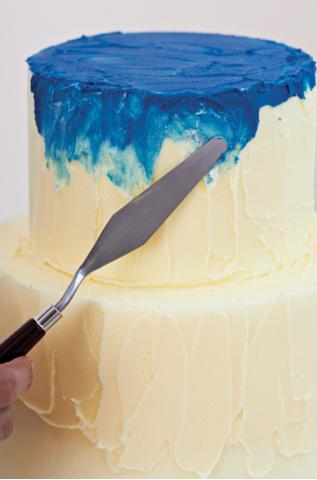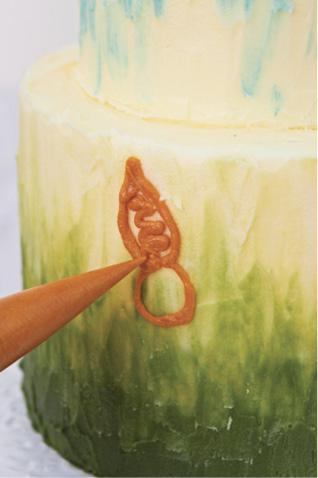Read The Contemporary Buttercream Bible Online
Authors: Christina Ong Valeri Valeriano
The Contemporary Buttercream Bible (27 page)
dip your palette knife in hot water when you
spread the buttercream.
304
To create this cake…
• 20 × 15cm (8 × 6in) square cake (bottom tier), 15
× 13cm (6 × 5in) square cake (top tier)
• 2.55–3.35kg (5lb 9oz–7lb 4oz) buttercream
• Paste colours: violet (Sugarflair Grape Violet),
lilac (Sugarflair Lilac), red (Sugarflair Ruby),
orange (Sugarflair Tangerine), yellow (Sugarflair
Autumn Leaf), light green (Sugarflair Gooseberry),
dark green (Sugarflair Spruce Green)
• Palette knife
• Small petal nozzle (Wilton 104)
• Piping bags
• Scissors
• Cake stand or covered cake board
Cover, dowel and stack the cakes (see Buttercream
Basics) and place on a stand or covered board.
Colour and thin the buttercream in the following
quantities: 250–350g (9–12oz) each of violet, lilac,
red, orange, yellow, light green, dark green, and
leave 250–350g (9–12oz) thinned but uncoloured.
Apply and blend the colours following the tutorial
and using the photograph of the finished cake as a
305
guide. Then with the remaining plain buttercream
and the small petal nozzle, pipe roses using the
freezing technique so that they can be squeezed
close together more easily around the base (see
Rose and Rose Bud, Piping Flowers).
306
Gradient Blending and
Painting Flowers
This is a method of blending a gentle gradient of
colour, and is great for creating a background on
which you can ‘paint’ using different palette knives.
These small tools will each give a different effect,
and we’ll show you how to use them to paint
stunning flowers. What is good about palette knife
painting is that you do not have to be precise with
the lines and shape, it is about blending. This
technique will definitely showcase the artist that
you are, or will release the hidden art talent that
you think you don’t have.
1 Select your colours and fill individual piping bags with them. Choose colours that grade from light to
dark, such as the greens we have used here. Apply a
textured covering of plain buttercream all over your
cake (see Palette Knife Brush Strokes) (A). You will
be blending the lightest of the colours with the plain buttercream before it crusts.
307

A
2 To create a gradient that is darkest at the top of
the cake, for a sky-like effect for example, pipe the colour on to the top of the cake (B), then spread it
using a palette knife (see Blending). Gradually
blend it into the plain buttercream (see Tip) (C).
308


B
C
309

3 To create a dark to light gradient from the base of the cake, start at the bottom edge. Using the
technique described above, pipe your second colour
next to the first leaving a small gap in between.
Spread it, then blend the first two colours together
(D). Blend the lighter colour into the plain
buttercream (E).
D
310

E
4 To add more colour gradient blending effect in
the background, pipe a small amount of colour on
top of the white then gradually blend to the
background (F).
311

F
Tip
Do not keep stroking the dark colour into the
light as your dark colour will overpower your
light-coloured buttercream, just gradually blend
the colours.
312
Palette Knife Flowers
Tip
Look at your cake as a big canvas and decide
how you will arrange your flowers. You can
help to visualize the overall design by using
tinted buttercream to pipe the centres of the
flowers so you have a guide as to their
positions.
1 For the sunflower, pipe a flower centre and guide
petals, then fill them slightly using the same colour (A). Using the shorter length palette knife, position it at a 10–20 degree angle and spread the
buttercream, following the shape of the petal you
have piped. Stroke from the base of the petal to the
tip on one side, then use the same stroke on the
other side then once more up the middle (B). Avoid
going back and forth so the finish is neat and always make sure to wipe your palette knife every after a
stroke. Repeat to create all the petals on your first flower.
313

A
314

B
2 You can add a shadow effect by piping a small
blob of a darker shade of tinted buttercream at the
base of each of the petals then repeat the same
strokes to blend this colour in (C). Pipe the centre
of the flower and add dots in a lighter shade for a
realistic texture (D). Repeat to create more flowers
on your cake.
315

C
316
